Spirituality St John Eudes
APOSTLE OF MERCY
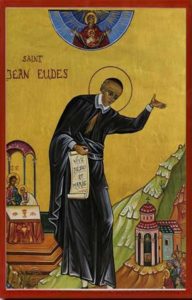
The origin of his spiritual adventure lies in his belief in a creative love that precedes us. Fruit of God’s eternal love, man was created in the divine image: a living image called to take part in the great designs of the Creator.
“God did not create the world only once, but countless times…
at all times He supports it and always preserves it”
Love has drawn man from nothing, Mercy will draw the sinner from his misery. And God’s plans will be magnificently restored with the arrival of Jesus, who will be faithful to his Father’s love and bearer of salvation for all.
JESUS THE CONCILIATOR
Jesus allows man to return by grace to the Father and He is himself a gift of God to man: He gives all to man. The gift of his life testifies that he is entirely consecrated to his Father and at the same time the Father accepts to give us his Son. (Vivere la spiritualità eudista, by Edouard Boudrault).
Jesus carried in His Heart all our miseries, He is the human and divine expression of God’s mercy, He is the incarnation of God’s mercy.
For St John Eudes, helping others to encounter God’s divine mercy means working for the salvation of souls: hence the purpose of his human and spiritual journey.
“Merciful is he who bears in his heart the miseries of the miserable”.
“WE ARE THE MISSIONARIES OF MERCY!”
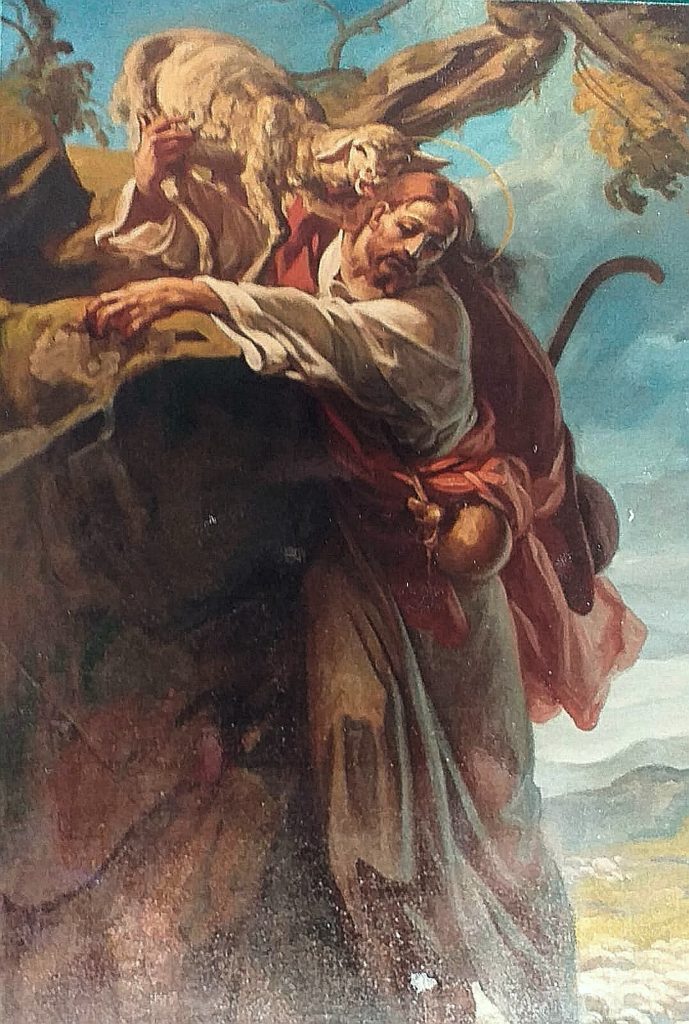
This exclamation written by John Eudes to his confreres in 1653, sounds like a promise and the result of an experience acquired over time: to welcome into one’s life the free gift of God’s mercy. (Saint John Eudes, Worker for the New Evangelization in the XVII Century by Luc Crepy and Marie-Françoise Le Brizaut, 2018).
John Eudes’ main concern was to find the best way to talk about the relationship between God and men. This was very much in line with Father Pierre de Bérulle, his spiritual guide, and with the movement that emerged from his impulse – the French School of Spirituality or Berullian School – was to find the best way to talk about the relationship between God and man.
The French School intentionally chose the path of interiority and communion of life with Jesus Christ. Young John shared that same desire to introduce the women and men of his time to holiness. He also embraced de Bérulle’s conviction that the Gospel must be interwoven with the web of daily existence: every moment of life, every thought must be related to Christ. The work of works is to form Jesus in us.
“A Christian is a member of Jesus Christ: ‘Do you not know that your bodies are members of Christ himself? ‘ (1Corinthians 6,15)”
cf. Le Baptème, Saint Jean Eudes, 1991.
FORMING CHRIST IN US
“Forming Christ in us”: This is the work to which we are all called to collaborate: that we allow ourselves to be formed by him. Through the power of the Spirit, the Father generates us to live in Christ and to adopt us as his children. Evangelization is that life in Christ communicated to the world, that is, committed to forming Christ in the souls of the baptized (cf. Galatians 4:19).
“Jesus must live in you in such a way that you can say to yourselves with the Apostle: “Christ lives in me (Galatians 2:20). He wants everything that is in him to live in you, his soul to live in your soul, his Heart in your heart, his Spirit in your spirit, and finally all his faculties to live and reign in the faculties of your soul and your body”(Oeuvres Complètes, VI, 107).
LITURGICAL WORSHIP OF THE SACRED HEART OF JESUS
The centrality of the personal relationship with Jesus Christ and the acceptance of his boundless love for each person are at the heart of all the spirituality of St John Eudes. He opens, through the strong image of the Heart, a spiritual path for every baptized person who, following Mary, is called to form Jesus in himself.
At first he speaks of the Heart of Mary, then his vision is enriched and united around the Heart of Jesus Christ. He is the first to compose an office and a Mass in honour of the Immaculate Heart of Mary and of the Sacred Heart of Jesus, celebrating them within his congregation. These activities caused him strong and violent objections on the part of the Jansenists. While the Jansenist heresy distanced people from the Sacraments of Reconciliation and the Eucharist, portraying a grim God who is unwilling to forgive the penitent, John exhorts souls to turn with confidence to the infinite mercy of God, fully revealed in the Son.
AVE COR
Hail, Heart most holy, Hail, Heart most meek, Hail, Heart most humble,
Hail, Heart most pure, Hail, Heart most devout, Hail, Heart most wise,
Hail, Heart most patient, Hail, Heart most obedient, Hail, Heart most vigilant,
Hail, Heart most faithful, Hail, Heart most blessed, Hail, Heart most merciful,
Hail, most loving Heart of Jesus and Mary;
We adore Thee, we praise Thee, we glorify Thee, We give Thee thanks;
We love Thee with all our heart, with all our soul, and with all our strength.
We offer Thee our heart; we give it to Thee; we consecrate it to Thee; we immolate it to Thee.
Receive it – and possess it wholly. Purify it, enlighten it, sanctify it.
That Thou mayest live and reign in it now and forever. Amen!
With St John Eudes we are in the presence of a spiritual experience centred on a personal encounter with God, concretely manifested in his works – as a missionary – in his foundations – as initiator of three apostolic groups – and as a writer – in his books – thanks to which, in 1925, Pope Pius XI gave him the title of “father, doctor and apostle of the liturgical cult of the Sacred Hearts of Jesus and Mary”.
“The devotion to the Sacred Heart of Jesus, of its very nature, is a worship of the love with which God, through Jesus, loved us, and at the same time, an exercise of our own love by which we are related to God and to other men. Or to express it in another way, devotion of this kind is directed towards the love of God for us in order to adore, give thanks, and live so as to imitate this Love; it is for this reason that we live that love by which we are bound to God to the rest of men to perfect fulfilment by carrying out daily more eagerly the new commandment which the divine Master gave to His Apostles as a sacred legacy when He said: ‘A new commandment I give to you, that you love one another as I have loved you. . .This is My commandment that you love one another as I have loved you’.” (Pius XII, Hauretis Aqua, Encyclical on the Devotion to the Sacred Heart, part IV, 1956).
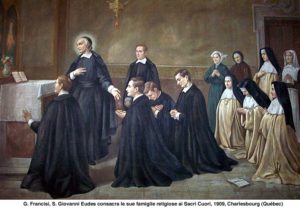
The Eudist Fathers and the Sisters of Our Lady of Charity of the Good Shepherd, with the support of several Episcopal conferences, have recently proposed his proclamation as Doctor of the Church for his doctrine on the Sacred Hearts, outlined in works such as The Life and Kingdom of Jesus and The Admirable Heart of Mary.
THE EUDIST PRAYER
A man of prayer, John Eudes had at heart to allow everyone to freely engage in a simple and accessible spiritual practice. Throughout his life he composed, both for the brothers and sisters of his foundations and for all Christians, numerous prayers suitable for all moments of the day, the major events of life, the most important festivities of the Church.
One of the most characteristic prayers of his spirituality is “the morning prayer”, typical of the Eudist prayer, created for a short and intense time of community prayer. The interest of this prayer lies in the structure that John Eudes decided to give to it, a movement that unfolds over four moments: “Let us worship, give thanks, ask forgiveness, give ourselves” in which we can try to structure the relationship with God and with men. In fact, prayer strengthens the bonds of communion with God and among us; it is a task and a grace that unites us and makes us united for the Mission.
Let us worship
Prayer always begins with a moment of worship. It is about becoming aware of God’s dazzling mystery and bringing to completion what Jesus lived on earth. Through our prayer we participate in the prayer of the Son. For Him, in Him and with Him, we worship the Father in the Spirit and in truth (John 4:22-24).
Let us give thanks
Worship frees in us, later on, all our capacity for gratitude. To worship, to wonder is to give thanks: this fundamental attitude permeates the very life of St John Eudes. Little by little he emptied himself, through strenuous trials that neither hardened him nor made him fall into resentment or bitterness, but opened up paths that freed in him the capacity to give thanks that even he himself never imagined he had within him.
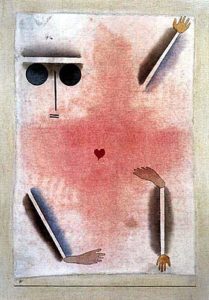
Let us ask forgiveness
The first two moments of the Eudist prayer are marked by a decentralization from ourselves: first worship God, then thank Him. During the third moment, introduced by the movement of the previous two, we can return to ourselves and, there, makeourselves transparent. Daring to ask forgiveness does not crush us, but on the contrary it frees us and calls us to live with a new responsibility. We are all sinners, and our prayer is not true in Him unless we are in a state of ongoing conversion.
Let us give ourselves
Conversion, and the acceptance of the forgiveness that has already been offered, provoke a new impetus in us: they set us in motion and allow us to respond to our baptismal vocation in the world; to give ourselves once again to the service of others, surrendering to the Spirit and showing the most radical readiness, that is, the path towards holiness.
The prayer lived by John Eudes is therefore an appeal to the Spirit, a kind of small “epiclesis”: we ask the Father to send the Spirit of Jesus into us so that we can give continuity and bring to completion “the states and mysteries of Jesus” and so that we can continue to “form” Jesus in us. There is a call to responsibility, to freedom, to growth, to the fullness of our lives… which are fruits of the acceptance and work of the Holy Spirit in us. (Saint John Eudes, Worker for the New Evangelization in the XVII Century by Luc Crepy and Marie-Françoise Le Brizaut, 2018).
AN EXISTENCE IN AN AGE OF RENEWAL
John Eudes (Caen, 1601-1680) was born into a family of peasants in Normandy, a few months after the birth of the future King Louis XIII, known as the Just: the gloomy period of the Thirty Years’ civil war between Catholics and Protestants that had completely ruined a Church already undermined by many miseries was coming to an end. He lived through the Grand Siècle, a tumultuous and compelling century of conflicts within Christianity, of intellectual investigation, of mystical search for renewal of the Church. A time of pastoral reforms, of renewal of the monastic orders, of creation of new congregations and of the establishment of the Carmel in France: in the 17th century the world was taking a new shape, with the advent of modern science and the Copernican revolution.
But the generation preceding his had already begun the work to reform the Church and Christian life: it was the “new evangelization” in line with the Council of Trent (1545-1563). Among the most well-known:
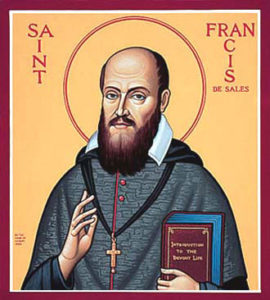
St Francis de Sales, born in 1567 (native of Savoy, Bishop of Geneva and Doctor of the Church, brilliant writer and teacher of spirituality) who succeeded in bringing back into communion with the Church many Calvinists of the Chablais region. The people he could not reach physically with his preaching, he reached through a new system of printing and hanging “posters” written in a light and effective style, in pubblic places. This is why Pius XI, in 1923, proclaimed him patron saint of journalists;
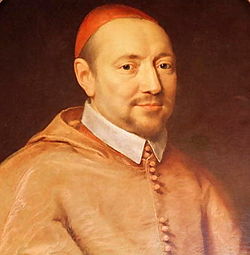
Pierre de Bérulle, born in 1575 who contributed to the mystical current of the seventeenth century about the renewed and passionate vision of the Incarnation that allows man to gain access to the hidden God;
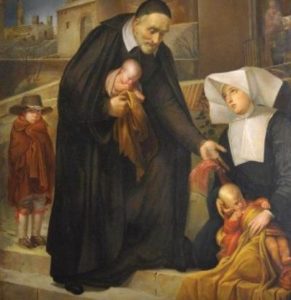
Saint Vincent de Paul, born in 1581, founder and inspiration of numerous male and female Congregations including the Daughters of Charity, who came from Gascony and is known as the Thomas Aquinas of charity. Just as St Thomas gave the Christian world a masterpiece of theology with his Summa Theologica, so St Vincent de Paul, with his institutions, gave men the masterpiece of charity. He was able to gather in his soul all that Catholic generosity, as the ages passed, had found to lift pain and poverty.
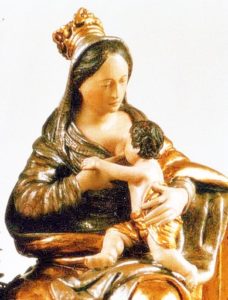
He grew up in a climate that evoked spiritual and social challenges. His parents consecrated him birth to Mary and later on, as an adolescent, he consecrated himself to her personally, receiving great graces from her, to the point that at the age of twenty-seven, in 1668, he drew up a “contract of alliance” with Our Lady, written in his own hand and with which he wanted to be buried. On his desk there was always a statue of Our Lady breastfeeding Jesus, and he told her all his travels, projects and missions.
During his relatively quiet and simple childhood in the countryside, an event marked him deeply. He would mention it later in his diary (Le Mémorial des bienfaits de Dieu, Memorial of God’s gifts): his first communion on the day of Pentecost. “I began to get to know God” and full of zeal he decided to consecrate himself entirely, in body and soul.
Educated by the Jesuits – who through their Colleges acted as pointers for the great renewal that was being designed – John, at the age of twenty decided to become a priest. There were many priests at the time: it was an enviable condition in which many families tried to place their children, but few of them lived it as a spiritual mission, in fact, it was often the opposite! John Eudes was aware of this and he himself aimed higher. Instead of becoming a Jesuit, he entered a community that had just opened in Caen: it was the Oratory of Jesus, founded a few years earlier in Paris (1611) precisely by Pierre de Bérulle. It was not a religious house, but a community of priests who, simply because they were priests, lived together and consecrated themselves completely to the service of the Gospel. In the Oratory, John Eudes found a fraternity of priests immersed in the full dynamism and fervour of its beginning; no religious vows were professed there: the commitments made by ordination to the priesthood and community life traced out the path to perfection. The Oratory of Jesus was an extremely lively community, in which theological research – based on a solid training in Sacred Scripture and the Fathers of the Church – attracted young people of great potential, enthusiastic about the idea of participating in the renewal of the Church, as well as willing to devote themselves to bringing to light the central treasure of faith, the mystery of the “Word made flesh”, “Jesus the true sun and the true centre of the world”, around which everything gravitates, as claimed by Bérulle, who ordained him priest in Paris on 20 December 1625.
Two years after his ordination, he went to help the plague victims of his native diocese: “From 1627 to 1638, a terrible plague sowed death and desolation throughout the Seez region. Alerted by his father, John Eudes decided to come to the aid of the unfortunate victims” (D. Boulay, I, 143).
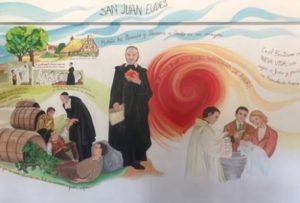
He lived in a barrel so as not to infect his brothers who warned him of “death in a short time and in such abandonment”. But John did not fear the plague, his concern was only for the victims (from Living Spirituality with St John Eudes, by Edouard Boudreault). He will repeat several times this heroic experience of assisting the victims of the plague.
From 1632 onwards, he devoted all his activity to the missions preached by the Oratorians: for several weeks, some priests from an institute, in connection with the local clergy, stayed in a parish and helped to renew Christian life. A mission lasted about a month and a half. The two main daily activities were preaching in the morning and catechism in the early afternoon. Catechesis took into account differences in age and status. The most strenuous occupation during the mission consisted in constantly hearing confessions. It often happened that John welcomed in the confessional women who were experiencing a problematic existence; women in irregular situations, abandoned, victims of violence, prostitutes, who found in him a benevolent and merciful refuge. For them, after various events, he opened together with lay people and lay collaborators the first Refuge in Caen in 1641, in a modest rented house. This is the first stone of what would later be the foundation of the Institute of Our Lady of Charity, approved by the Bishop ten years later and by Rome in 1666.
During his life, from 1632 to 1676, John Eudes took part in 117 missions: he thus witnessed the lack of spiritual education of the baptized, but above all of priests. He spiritually guided, with rigour and gentleness, numerous lay people, some of whom were invested with important responsibilities. He often extended to the laity the invitation to share his work in the missions and to live fully the dimension of their baptism at the service of evangelization and of the poor.
From 1641, during the missions, he got into the habit of bringing priests together in a special way. John clearly perceived that the fruit of the missions would not be consolidated unless well-trained priests in the field guaranteed pastoral continuity to the work begun by the missionaries. In fact, in order to have Christians trained in a manner more adequate and conscious of the baptismal grace that they received, there is a need for priests who are better educated and more capable in carrying out pastoral tasks. This double perspective lead John Eudes to consider the possibility of opening seminaries, but since this project did not meet with any positive response among the Oratorians, the decision to found a new congregation, whose members shall be assigned to the activities of the missions and of the seminaries, gradually developed in him.
The stroke of genius and audacity lay in the fact that the trainers had to be missionaries at the same time, and vice versa. John leaves the Oratorians and founds the Congregation of Jesus and Mary, whose act of birth coincides with the creation of the seminary of Caen on 25 March 1643.
In 1673, because of slander, he was banned from the court of Paris by Louis XIV and suddenly the existence of his Congregation was threatened. He patiently accepted this humiliation, courageously defending his innocence. Six years later, one year before his death with the support of friends close to him, he regained the king’s trust.
